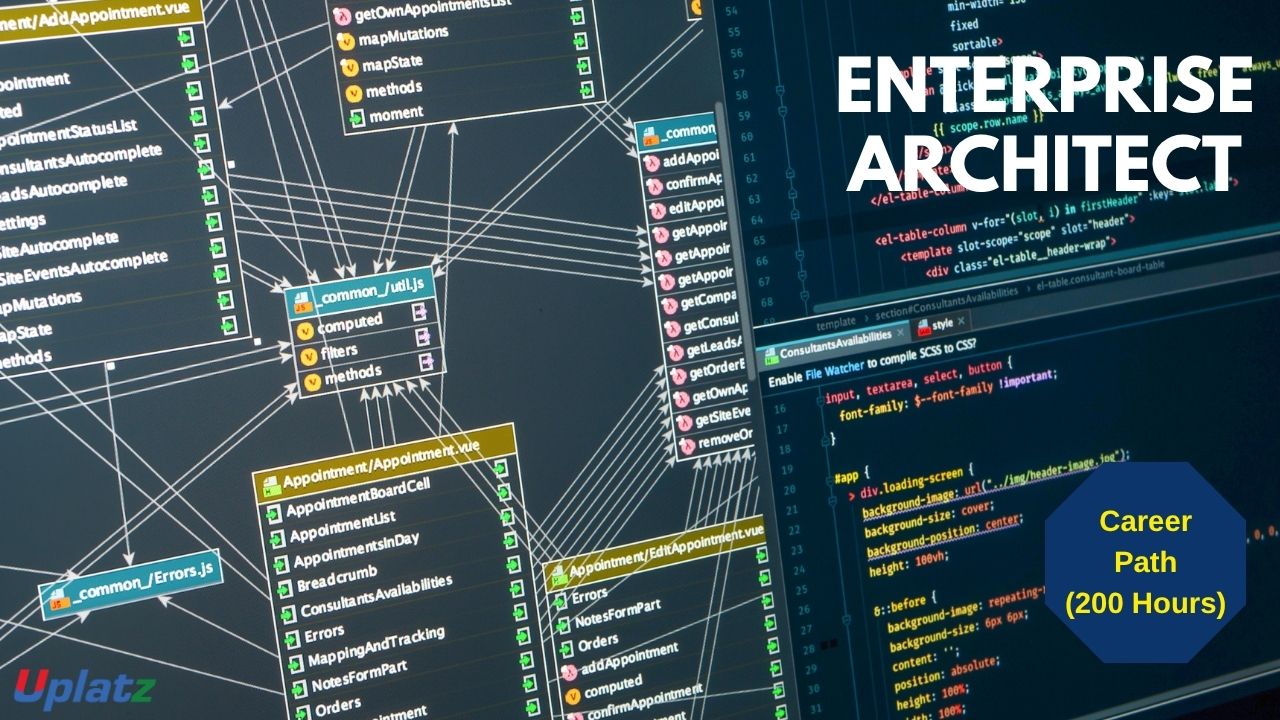Career Path - Domain Architect
Master domain-specific architecture and strategic alignment across industries with this in-depth Domain Architect career-building programme.Preview Career Path - Domain Architect course
Price Match Guarantee Full Lifetime Access Access on any Device Technical Support Secure Checkout Course Completion Certificate 89% Started a new career
BUY THIS COURSE (
89% Started a new career
BUY THIS COURSE (GBP 32 GBP 99 )-
 93% Got a pay increase and promotion
93% Got a pay increase and promotion
Students also bought -
-

- Career Path - Application Architect
- 200 Hours
- GBP 32
- 832 Learners
-

- Career Path - Database Administrator
- 50 Hours
- GBP 32
- 255 Learners
-

- Career Path - Enterprise Architect
- 200 Hours
- GBP 32
- 673 Learners

Career Path - Domain Architect (Self-Paced Online Course)
The role of a Domain Architect is more critical than ever in today’s complex and technology-driven business environment. Organizations increasingly rely on Domain Architects to provide deep, domain-specific expertise that drives both technical excellence and business alignment. This self-paced online course is your gateway to becoming a strategic leader in your chosen area of specialization—be it finance, healthcare, data, security, or enterprise systems.
The Career Path: Domain Architect course is thoughtfully designed to help professionals like you build advanced architectural skills, master the intricacies of specific business domains, and lead with confidence. It blends strategic thinking with practical application, enabling you to influence technology decisions, shape architectural roadmaps, and create solutions that are scalable, resilient, and aligned with enterprise goals.
Whether you're looking to grow within your current organization or position yourself for a senior architecture role in a new domain, this course equips you with the tools, techniques, and mindset to make that leap. You’ll be empowered to drive impactful change at the intersection of technology and business strategy.
What This Course Offers
This course provides comprehensive training on domain-specific architecture, covering both technical depth and business context. Through a series of pre-recorded, expert-led video sessions, you’ll gain insights into the best practices, frameworks, and tools used by successful Domain Architects.
Key areas explored in the course include:
- Domain modeling and solution design: Learn how to translate complex domain requirements into scalable, maintainable architectures.
- Business-IT alignment: Understand how to bridge the gap between business goals and technical solutions through collaboration and strategic planning.
- Stakeholder management: Build skills in communicating and negotiating with business leaders, developers, and cross-functional teams.
- Enterprise architecture principles: Align your domain-level solutions with enterprise-level architecture strategies and governance models.
- Risk and compliance awareness: Address domain-specific regulatory, security, and performance concerns effectively.
The course is intentionally broad in its architectural coverage while offering opportunities to dive deep into industry-relevant topics. Whether you specialize in healthcare systems, financial technologies, data platforms, cybersecurity, or cloud-native enterprise software, you will find examples, case studies, and challenges that mirror real-world architectural scenarios.
Who This Course Is For
This course is ideal for mid-to-senior-level professionals aiming to formalize or elevate their role as a Domain Architect. It is especially suited to:
- Solution Architects or Technical Leads seeking deeper specialization within a business domain
- Business Analysts or IT Consultants transitioning into architectural roles
- Enterprise Architects looking to lead domain-specific initiatives
- IT Managers or Project Leads guiding complex solution implementations
- Industry professionals (finance, healthcare, etc.) with a strong technical background who want to shape long-term architectural strategies
Whether you're in a product-driven tech company, a large enterprise, or a consulting firm, this course provides the architecture-centric viewpoint needed to guide strategic initiatives within a domain.
What You Will Gain
Upon completing this course, you will emerge with:
- A solid understanding of domain-driven design principles and how to apply them in real-world projects
- The capability to create architectural blueprints that reflect both business needs and system constraints
- Mastery of communication strategies that enable alignment across technical and business teams
- Familiarity with architecture documentation, modeling standards, and solution evaluation techniques
- The confidence to lead domain architecture reviews, define governance models, and shape domain-specific strategy
- A toolkit of templates, diagrams, checklists, and evaluation criteria to use in your daily work
You'll become a trusted authority within your domain, capable of influencing direction, driving consensus, and delivering architecture that makes a measurable difference.
How to Use This Course Effectively
To maximize the value of this self-paced course, you should approach it with a blend of structure, curiosity, and applied learning. Here are some practical ways to get the most out of the program:
1. Define Your Domain Focus Early
Before you begin, decide which domain you’re aiming to specialize in—whether it’s healthcare systems, financial services, cybersecurity, data platforms, or enterprise SaaS. This clarity will help you interpret the course material in the most relevant way and allow you to tailor your notes, reflections, and examples to your field.
2. Create a Personal Learning Schedule
Being self-paced means flexibility, but it also demands discipline. Establish a routine—perhaps 3 hours per week—and set realistic weekly goals. This steady approach allows for better retention and avoids cramming, especially when tackling more technical modules.
3. Apply Concepts to Your Work Context
With each module, try applying the concepts to challenges or projects from your current or past roles. For example, when learning about stakeholder alignment, reflect on a time you had to manage conflicting expectations and imagine how you could have used a domain architecture framework in that scenario.
4. Use the Tools and Templates Provided
Throughout the course, you’ll receive architecture templates, modeling tools, and decision-making frameworks. Don't just study them—use them. Practice filling in architectural blueprints, stakeholder matrices, or domain model diagrams based on a use case relevant to your domain.
5. Document a Portfolio Project
To consolidate learning, consider building a domain architecture proposal as a capstone project. Include sections like business context, domain overview, key constraints, architecture vision, high-level diagrams, stakeholder map, and risk assessment. This project can serve as a powerful portfolio asset or internal presentation in your company.
6. Engage in Self-Assessment
Many lessons are accompanied by case-based questions or hypothetical situations. Use these to check your understanding and think critically. Treat them as interview prep or rehearsal for real-world decision-making moments.
7. Revisit Complex Topics
Some topics—such as regulatory frameworks, enterprise integration, or scalability models—may require a second review. Don’t hesitate to rewatch modules. The platform is designed to be a lifelong learning tool that you can return to whenever you face new challenges.
8. Stay Updated and Expand Beyond the Course
Domains evolve. Financial systems adapt to fintech trends; healthcare incorporates IoT and patient portals; data platforms shift toward lakehouses and real-time streams. Use this course as a strong foundation and build on it by reading industry whitepapers, attending webinars, or joining architect communities on platforms like LinkedIn.
Take the Lead in Domain Architecture
The Career Path: Domain Architect self-paced course is more than just an educational program—it’s your launchpad into a high-impact, strategic role where technology meets domain mastery. You’ll learn not only how to architect solutions but how to shape the very strategy that guides them.
If you’re ready to lead architectural efforts with authority, clarity, and domain expertise, this course will give you everything you need to get there. It’s time to own your space, influence decision-making, and become the go-to architecture expert in your field.
Enroll now—and transform your domain knowledge into architectural leadership.
Course/Topic - Course access through Google Drive
-
Google Drive
-
Google Drive
By the end of this course, learners will be able to:
- Understand the role and responsibilities of a Domain Architect
- Master architectural principles within a specialized business or technology domain
- Translate business goals into domain-specific technology solutions
- Collaborate with cross-functional teams and stakeholders
- Drive architectural consistency, compliance, and innovation
- Provide guidance on solution design, implementation, and integration
- Stay current with emerging technologies in your chosen domain
- Prepare for domain-based certifications and leadership roles
Syllabus:
- Introduction to Domain Architecture
- Overview of domain architecture and its business value
- Role of Domain Architect vs. Enterprise/Solution Architect
- Defining and Understanding Your Domain
- Deep dive into domain modeling
- Scoping business and technical domain boundaries
- Architecture Principles and Governance
- Applying architectural standards and reference models
- Ensuring alignment with enterprise architecture
- Requirement Gathering and Stakeholder Collaboration
- Understanding business needs
- Working with technical teams, analysts, and business leaders
- Solution Planning and Technical Guidance
- Designing scalable, secure, and cost-effective domain solutions
- Tool selection and technology stack alignment
- Domain-Specific Use Cases and Scenarios
- Industry-specific case studies (e.g., healthcare, finance, security)
- Real-world architecture patterns
- Integration, Interoperability & Compliance
- Ensuring domain solutions integrate with enterprise systems
- Meeting regulatory and operational compliance requirements
- Documentation, Roadmapping & Reviews
- Creating architectural artifacts and blueprints
- Conducting architecture reviews and audits
- Emerging Trends and Technologies in Domains
- Staying current with domain-relevant innovations
- Examples: AI in healthcare, blockchain in finance, zero-trust in security
- Career Growth & Certification Preparation
- Navigating architectural career tracks
- Resume building and interview preparation
Upon successful completion of this course, learners will receive a Course Completion Certificate from Uplatz, validating their proficiency in domain-specific architecture, strategy, and implementation.
This Uplatz certification demonstrates your expertise in guiding solutions within a focused business or technical domain, enhancing your credibility with employers and peers. It serves as a valuable asset for career growth in architecture, consulting, and leadership.
The course also prepares learners for certifications aligned with specific domains, such as TOGAF®, SABSA for security, DAMADMBOK for data, or industry-specific programs for finance, healthcare, or manufacturing architecture.
Domain Architects are in growing demand across all industries as organizations require deep expertise to guide technology decisions within specialized areas. Their insights help ensure that technology investments align with business strategy and regulatory needs.
Career Opportunities Include:
- Domain Architect (Finance, Healthcare, Security, Data, etc.)
- Technical Solution Architect (specialized domain)
- Business Technology Architect
- Industry-Specific IT Consultant
- Lead Systems Architect
Industries Hiring Domain Architects:
Banking, healthcare, insurance, retail, telecommunications, defense, manufacturing, public sector, and consulting.
Career Progression Options:
- Senior Domain Architect
- Chief Architect (Domain)
- Director of Architecture
- Enterprise Architecture Consultant
- Strategic Technology Advisor
This course provides the foundational and advanced skills needed to progress from domain-specific roles into enterprise-wide architectural leadership.
1. What is the role of a Domain Architect?
A Domain Architect focuses on a specific business or technical area, ensuring architectural consistency, solution alignment, and domain-specific guidance.
2. How does a Domain Architect differ from a Solution Architect?
A Solution Architect focuses on project-specific solutions, while a Domain Architect oversees architectural strategy and decisions across a business or technical domain.
3. What are key responsibilities in a domain-specific architecture role?
Requirement gathering, solution design, stakeholder alignment, governance enforcement, and ensuring interoperability within and beyond the domain.
4. Why is domain expertise important in architecture?
Deep domain knowledge ensures that architectural decisions meet business needs, regulatory requirements, and industry best practices.
5. What tools and frameworks are commonly used by Domain Architects?
TOGAF, ArchiMate, domain-specific frameworks (e.g., DAMA-DMBOK, HL7), UML tools, modeling platforms, and collaboration tools like Confluence.
6. How do you align domain architecture with enterprise strategy?
By collaborating with enterprise architects, aligning roadmaps, and ensuring architectural decisions support strategic goals and business KPIs.
7. What is a domain reference model?
A standardized blueprint that guides solution architecture within a domain, ensuring consistency and reusability.
8. How do Domain Architects influence cross-functional teams?
Through technical leadership, clear communication, stakeholder management, and continuous engagement across departments.
9. What are common challenges in domain architecture?
Siloed systems, lack of stakeholder alignment, evolving regulatory needs, and managing complexity across legacy and modern systems.
10. How do you stay updated within your domain?
By attending industry conferences, following domain-specific publications, participating in communities of practice, and engaging in continuous education.









